实验3
实验任务1:

1 #pragma once 2 #include <iostream> 3 #include <string> 4 using std::string; 5 using std::cout; 6 7 // 按钮类 8 class Button { 9 public: 10 Button(const string &text); 11 string get_label() const; 12 void click(); 13 private: 14 string label; 15 }; 16 17 Button::Button(const string &text): label{text} {} 18 19 inline string Button::get_label() const { 20 return label; 21 } 22 23 void Button::click() { 24 cout << "Button '" << label << "' clicked\n"; 25 }

1 #pragma once 2 #include "button.hpp" 3 #include <vector> 4 #include <iostream> 5 using std::vector; 6 using std::cout; 7 using std::endl; 8 9 // 窗口类 10 class Window { 11 public: 12 Window(const string &win_title); 13 void display() const; 14 void close(); 15 void add_button(const string &label); 16 private: 17 string title; 18 vector<Button> buttons; 19 }; 20 21 Window::Window(const string &win_title): title{win_title} { 22 buttons.push_back(Button("close")); 23 } 24 25 inline void Window::display() const { 26 string s(40, '*'); 27 cout << s << endl; 28 cout << "window title: " << title << endl; 29 cout << "It has " << buttons.size() << " buttons: " << endl; 30 for(const auto &i: buttons) 31 cout << i.get_label() << " button" << endl; 32 cout << s << endl; 33 } 34 35 void Window::close() { 36 cout << "close window '" << title << "'" << endl; 37 buttons.at(0).click(); 38 } 39 40 void Window::add_button(const string &label) { 41 buttons.push_back(Button(label)); 42 }

1 #include "window.hpp" 2 #include <iostream> 3 using std::cout; 4 using std::cin; 5 6 void test() { 7 Window w1("new window"); 8 w1.add_button("maximize"); 9 w1.display(); 10 w1.close(); 11 } 12 13 int main() { 14 cout << "用组合类模拟简单GUI:\n"; 15 test(); 16 }
问题1:
1. 自定义的类:
Button 类
Window 类
2. 使用到的标准库类:
std::string:用于处理字符串。
std::vector:用于存储 `Button` 对象的动态数组。
std::cout:用于输出信息到控制台。
3. 组合关系:
window---{string,button vector}
button----{string}
问题2:
回答:
1. 适合添加 const 的成员函数:
button 中click可以加const,因为它没改变类的成员。
Window中的close 也可以加const.
2. 适合设置成 inline 的成员函数:
Button 类中的click函数可以考虑设置为 inline,因为它是一个简单的函数,通常会在头文件中定义以提高效率。
Window 类中的 display() 函数可以考虑设置为 inline,如果它的实现较简单且频繁调用。
问题3:
回答:
功能是创建一个有40个‘*’的字符串,美化运行窗口,增强终端可读性和易用性
实验任务2:

1 #include <iostream> 2 #include <vector> 3 using namespace std; 4 void output1(const vector<int> &v) { 5 for(auto &i: v) 6 cout << i << ", "; 7 cout << "\b\b \n"; 8 } 9 void output2(const vector<vector<int>> v) { 10 for(auto &i: v) { 11 for(auto &j: i) 12 cout << j << ", "; 13 cout << "\b\b \n"; 14 } 15 } 16 void test1() { 17 vector<int> v1(5, 42); 18 const vector<int> v2(v1); 19 v1.at(0) = -999; 20 cout << "v1: "; output1(v1); 21 cout << "v2: "; output1(v2); 22 cout << "v1.at(0) = " << v1.at(0) << endl; 23 cout << "v2.at(0) = " << v2.at(0) << endl; 24 } 25 void test2() { 26 vector<vector<int>> v1{{1, 2, 3}, {4, 5, 6, 7}}; 27 const vector<vector<int>> v2(v1); 28 v1.at(0).push_back(-999); 29 cout << "v1: \n"; output2(v1); 30 cout << "v2: \n"; output2(v2); 31 vector<int> t1 = v1.at(0); 32 cout << t1.at(t1.size()-1) << endl; 33 const vector<int> t2 = v2.at(0); 34 cout << t2.at(t2.size()-1) << endl; 35 } 36 int main() { 37 cout << "测试1:\n"; 38 test1(); 39 cout << "\n测试2:\n"; 40 test2(); 41 }
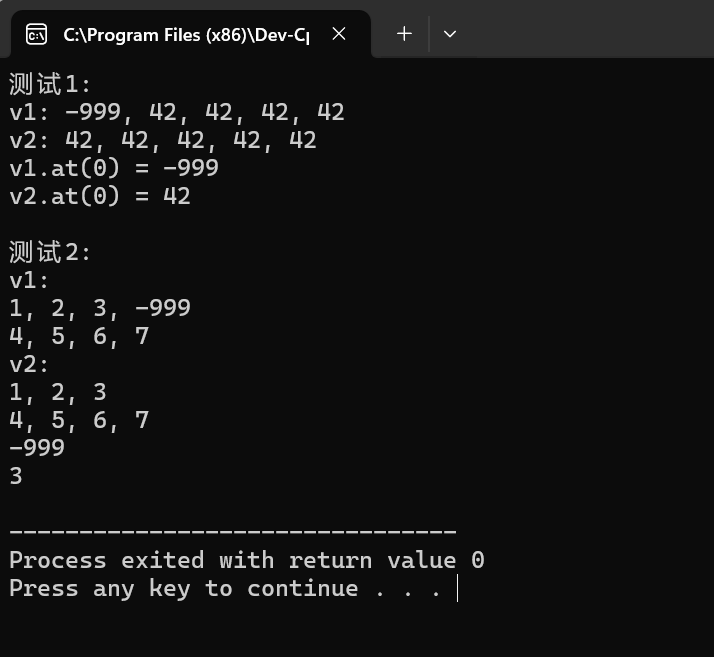
问题1:
vector<int> v1(5, 42);:创建一个包含5个元素,值为42的向量。
const vector<int> v2(v1);:使用v1初始化v2,进行深复制,v2的内容与v1相同,但它们是独立的。
v1.at(0) = -999;:修改v1的第一个元素为-999。
问题2:
测试2模块中,这三行代码的功能分别是:
vector<vector<int>> v1{{1, 2, 3}, {4, 5, 6, 7}};:创建一个二维向量,包含两个子向量。
const vector<vector<int>> v2(v1);:深复制v1到v2,v2的内容与v1相同。
v1.at(0).push_back(-999);:在v1的第一个子向量中添加元素-999。
问题3:
测试2模块中,这四行代码的功能分别是:
vector<int> t1 = v1.at(0);:定义一个整数容器t1,将v1中索引为0的容器的元素赋给它;
cout << t1.at(t1.size()-1)<<endl;:输出t1中最后一个元素并换行;
const vector<int> t2 = v2.at(0);:获取v2的第一个子向量并赋值给t2。
cout << t2.at(t2.size()-1) << endl;:输出t2的最后一个元素。
问题4:
根据执行结果,反向分析、推断:
① 标准库模板类vector内部封装的复制构造函数,其实现机制是深复制。
② 是,模板类vector的接口at(),确实至少需要提供一个const成员函数作为接口,以便在需要只读访问时使用。
实验任务3:

1 #pragma once 2 #include <iostream> 3 #include <cassert> 4 using std::cout; 5 using std::endl; 6 7 // 动态int数组对象类 8 class vectorInt { 9 public: 10 vectorInt(int n); // 构造函数,指定大小 11 vectorInt(int n, int value); // 构造函数,指定大小并初始化 12 vectorInt(const vectorInt &vi); // 复制构造函数 13 ~vectorInt(); // 析构函数 14 15 int& at(int index); // 返回指定索引的元素引用 16 const int& at(int index) const; // 返回指定索引的元素常量引用 17 vectorInt& assign(const vectorInt &v); // 赋值操作 18 int get_size() const; // 返回数组大小 19 20 private: 21 int size; // 数组大小 22 int *ptr; // 指向动态数组的指针 23 }; 24 25 // 构造函数实现 26 vectorInt::vectorInt(int n) : size{n}, ptr{new int[size]} { 27 } 28 29 vectorInt::vectorInt(int n, int value) : size{n}, ptr{new int[size]} { 30 for (auto i = 0; i < size; ++i) 31 ptr[i] = value; 32 } 33 34 vectorInt::vectorInt(const vectorInt &vi) : size{vi.size}, ptr{new int[size]} { 35 for (auto i = 0; i < size; ++i) 36 ptr[i] = vi.ptr[i]; 37 } 38 39 vectorInt::~vectorInt() { 40 delete[] ptr; // 释放动态数组内存 41 } 42 43 const int& vectorInt::at(int index) const { 44 assert(index >= 0 && index < size); 45 return ptr[index]; 46 } 47 48 int& vectorInt::at(int index) { 49 assert(index >= 0 && index < size); 50 return ptr[index]; 51 } 52 53 vectorInt& vectorInt::assign(const vectorInt &v) { 54 delete[] ptr; // 释放原有内存 55 size = v.size; 56 ptr = new int[size]; 57 for (int i = 0; i < size; ++i) 58 ptr[i] = v.ptr[i]; 59 return *this; 60 } 61 62 int vectorInt::get_size() const { 63 return size; 64 }

1 #include "vectorInt.hpp" 2 #include <iostream> 3 using std::cin; 4 using std::cout; 5 6 void output(const vectorInt &vi) { 7 for (auto i = 0; i < vi.get_size(); ++i) 8 cout << vi.at(i) << ", "; 9 cout << "\b\b \n"; // 删除最后一个逗号 10 } 11 12 void test1() { 13 int n; 14 cout << "Enter n: "; 15 cin >> n; 16 vectorInt x1(n); // 创建大小为n的vectorInt对象 17 for (auto i = 0; i < n; ++i) 18 x1.at(i) = i * i; // 初始化数据 19 cout << "x1: "; output(x1); 20 21 vectorInt x2(n, 42); // 创建大小为n,所有元素初始化为42的vectorInt对象 22 vectorInt x3(x2); // 使用x2创建x3,调用复制构造函数 23 24 x2.at(0) = -999; // 修改x2的第一个元素 25 cout << "x2: "; output(x2); 26 cout << "x3: "; output(x3); // x3应保持不变 27 } 28 29 void test2() { 30 const vectorInt x(5, 42); // 创建大小为5,所有元素初始化为42的vectorInt对象 31 vectorInt y(10, 0); // 创建大小为10,所有元素初始化为0的vectorInt对象 32 cout << "y: "; output(y); 33 y.assign(x); // 将x的值赋给y 34 cout << "y: "; output(y); 35 cout << "x.at(0) = " << x.at(0) << endl; // 输出x的第一个元素 36 cout << "y.at(0) = " << y.at(0) << endl; // 输出y的第一个元素 37 } 38 39 int main() { 40 cout << "测试1: \n"; 41 test1(); 42 cout << "\n测试2: \n"; 43 test2(); 44 }
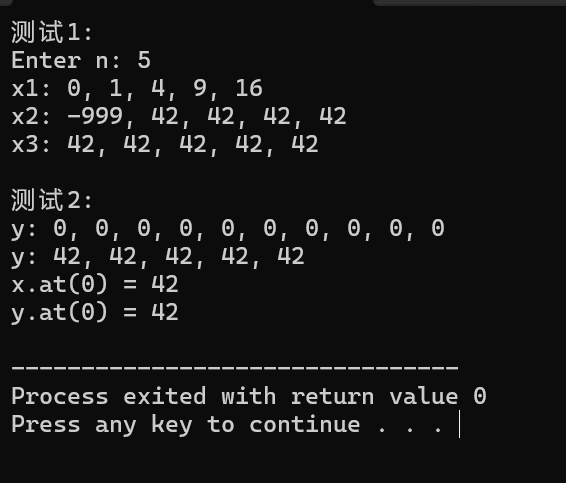
问题1:复制构造函数实现为深复制。它通过分配新的内存并将原对象的内容逐个复制到新对象中,确保每个对象都有自己的独立数据。
问题2:不能运行,报错截图如下

因为返回值不是引用类型的话,就无法完成修改成员值的操作,所以会报错。有潜在安全隐患。可能会被错误调用。
问题3:assign()接口的返回值类型可以改成vectorInt,但不如使用assign()接口。返回引用(vectorInt&)可以支持链式调用,而返回值会导致对象的拷贝,增加不必要的开销。因此,返回引用更好。
实验任务4:

1 #pragma once 2 #include <iostream> 3 #include <cassert> 4 using std::cout; 5 using std::endl; 6 7 // 类Matrix的声明 8 class Matrix { 9 public: 10 Matrix(int n, int m); // 构造函数,构造一个n*m的矩阵, 初始值为value 11 Matrix(int n); // 构造函数,构造一个n*n的矩阵, 初始值为value 12 Matrix(const Matrix& x); // 复制构造函数, 使用已有的矩阵X构造 13 ~Matrix(); 14 15 void set(const double* pvalue); // 用pvalue指向的连续内存块数据按行为矩阵赋值 16 void clear(); // 把矩阵对象的值置0 17 18 const double& at(int i, int j) const; // 返回矩阵对象索引(i,j)的元素const引用 19 double& at(int i, int j); // 返回矩阵对象索引(i,j)的元素引用 20 21 int get_lines() const; // 返回矩阵对象行数 22 int get_cols() const; // 返回矩阵对象列数 23 24 void display() const; // 按行显示矩阵对象元素值 25 26 private: 27 int lines; // 矩阵对象内元素行数 28 int cols; // 矩阵对象内元素列数 29 double* ptr; 30 }; 31 32 Matrix::Matrix(int n, int m) : lines{ n }, cols{ m }, ptr{ new double[lines * cols] } {} 33 Matrix::Matrix(int n) : lines{ n }, cols{ n }, ptr{ new double[lines * cols] } {} 34 Matrix::Matrix(const Matrix& x) : lines{ x.lines }, cols{ x.cols }, ptr{ new double[lines * cols] } { 35 for (int i = 0; i < lines * cols; ++i) { 36 ptr[i] = x.ptr[i]; 37 } 38 } 39 Matrix::~Matrix() { 40 delete []ptr; 41 } 42 43 44 void Matrix::set(const double* pvalue) { 45 for (int i = 0; i < lines; ++i) { 46 for (int j = 0; j < cols; ++j) { 47 ptr[i * cols + j] = pvalue[i * cols + j]; 48 } 49 } 50 } 51 void Matrix::clear() { 52 for (int i = 0; i < lines * cols; ++i) { 53 ptr[i] = 0; 54 } 55 } 56 const double& Matrix::at(int i, int j) const { 57 if(i >= 0 && i < lines && j >= 0 && j < cols) 58 return ptr[i * cols + j]; 59 } 60 double& Matrix::at(int i, int j) { 61 if(i >= 0 && i < lines && j >= 0 && j < cols) 62 return ptr[i * cols + j]; 63 } 64 int Matrix::get_lines() const { return lines; } 65 int Matrix::get_cols() const { return cols; } 66 void Matrix::display() const { 67 for (int i = 0; i < lines; ++i) { 68 for (int i1 = 0; i1 < cols; ++i1) { 69 cout << ptr[i * cols + i1] << ", "; 70 } 71 cout << "\b\b \n"; 72 } 73 }

1 #include "matrix.hpp" 2 #include <iostream> 3 #include <cassert> 4 5 using std::cin; 6 using std::cout; 7 using std::endl; 8 9 10 const int N = 1000; 11 12 // 输出矩阵对象索引为index所在行的所有元素 13 void output(const Matrix &m, int index) { 14 assert(index >= 0 && index < m.get_lines()); 15 16 for(auto j = 0; j < m.get_cols(); ++j) 17 cout << m.at(index, j) << ", "; 18 cout << "\b\b \n"; 19 } 20 21 22 void test1() { 23 double x[1000] = {1,3,5,2,4,6,7,8,9}; 24 25 int n, m; 26 cout << "Enter n and m: "; 27 cin >> n >> m; 28 29 Matrix m1(n, m); // 创建矩阵对象m1, 大小n×m 30 m1.set(x); // 用一维数组x的值按行为矩阵m1赋值 31 32 Matrix m2(m, n); // 创建矩阵对象m2, 大小m×n 33 m2.set(x); // 用一维数组x的值按行为矩阵m1赋值 34 35 Matrix m3(2); // 创建一个2×2矩阵对象 36 m3.set(x); // 用一维数组x的值按行为矩阵m4赋值 37 38 cout << "矩阵对象m1: \n"; m1.display(); cout << endl; 39 cout << "矩阵对象m2: \n"; m2.display(); cout << endl; 40 cout << "矩阵对象m3: \n"; m3.display(); cout << endl; 41 } 42 43 void test2() { 44 Matrix m1(2, 3); 45 m1.clear(); 46 47 const Matrix m2(m1); 48 m1.at(0, 0) = -999; 49 50 cout << "m1.at(0, 0) = " << m1.at(0, 0) << endl; 51 cout << "m2.at(0, 0) = " << m2.at(0, 0) << endl; 52 cout << "矩阵对象m1第0行: "; output(m1, 0); 53 cout << "矩阵对象m2第0行: "; output(m2, 0); 54 } 55 56 int main() { 57 cout << "测试1: \n"; 58 test1(); 59 60 cout << "测试2: \n"; 61 test2(); 62 }
运行结果截图:
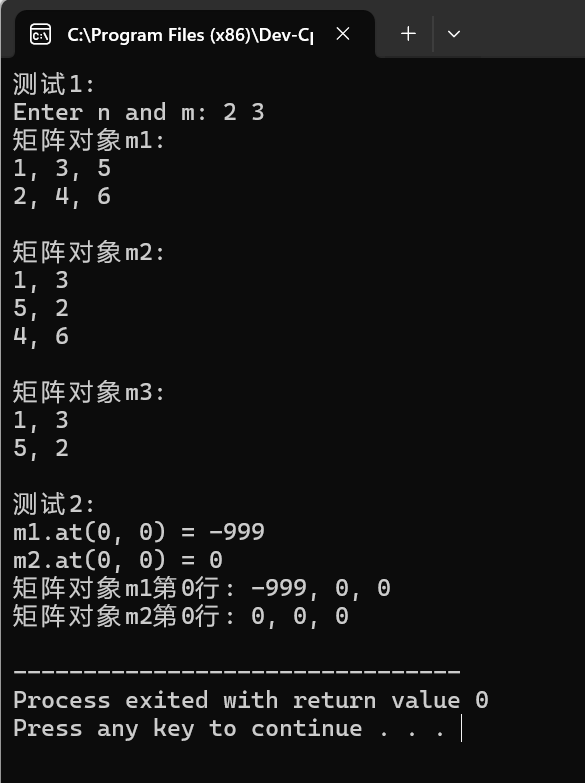
实验任务5:

1 #pragma once 2 #include <iostream> 3 #include <string> 4 #include <vector> 5 6 using std::string; 7 using std::cout; 8 using std::endl; 9 using std::vector; 10 11 class User { 12 public: 13 User(const string& name, const string& password = "123456", const string& email = ""); 14 void set_email(); 15 void change_password(); 16 void display(); 17 private: 18 string name; 19 string password; 20 string email; 21 }; 22 23 User::User(const string& name, const string& password, const string& email) : name{ name }, password{ password }, email{ email } {} 24 25 void User::set_email() { 26 string input; 27 bool c = false; 28 cout << "Enter email address: "; 29 do { 30 31 std::cin >> input; 32 size_t pos = input.find('@'); 33 if (pos != string::npos) { 34 c = true; 35 } 36 else { 37 cout << "illegal email. Please re-enter email: "; 38 } 39 } while (!c); 40 email = input; 41 cout << "email is set successfully..." << endl; 42 } 43 44 void User::change_password() { 45 string old_password; 46 string new_password; 47 int cnt = 0; 48 bool correct = false; 49 cout << "Enter old password: "; 50 do { 51 52 std::cin >> old_password; 53 if (old_password == password) { 54 correct = true; 55 } 56 else { 57 cnt++; 58 if (cnt == 3) { 59 cout << "password input error. Please try after a while." << endl; 60 return; 61 } 62 cout << "password input error. Please re-enter again: "; 63 } 64 } while (!correct); 65 cout << "Enter new password: "; 66 std::cin >> new_password; 67 password = new_password; 68 cout << "new password is set successfully..." << endl; 69 } 70 71 void User::display() { 72 cout << "name: " << name << endl; 73 string showpassword(password.length(), '*'); 74 cout << "pass: " << showpassword << endl; 75 cout << "email: " << email << endl; 76 }

1 #include "user.hpp" 2 #include <iostream> 3 #include <vector> 4 #include <string> 5 6 using std::cin; 7 using std::cout; 8 using std::endl; 9 using std::vector; 10 using std::string; 11 12 void test() { 13 vector<User> user_lst; 14 15 User u1("Alice", "2024113", "Alice@hotmail.com"); 16 user_lst.push_back(u1); 17 cout << endl; 18 19 User u2("Bob"); 20 u2.set_email(); 21 u2.change_password(); 22 user_lst.push_back(u2); 23 cout << endl; 24 25 User u3("Hellen"); 26 u3.set_email(); 27 u3.change_password(); 28 user_lst.push_back(u3); 29 cout << endl; 30 31 cout << "There are " << user_lst.size() << " users. they are: " << endl; 32 for(auto &i: user_lst) { 33 i.display(); 34 cout << endl; 35 } 36 } 37 38 int main() { 39 test(); 40 }
实验结果:
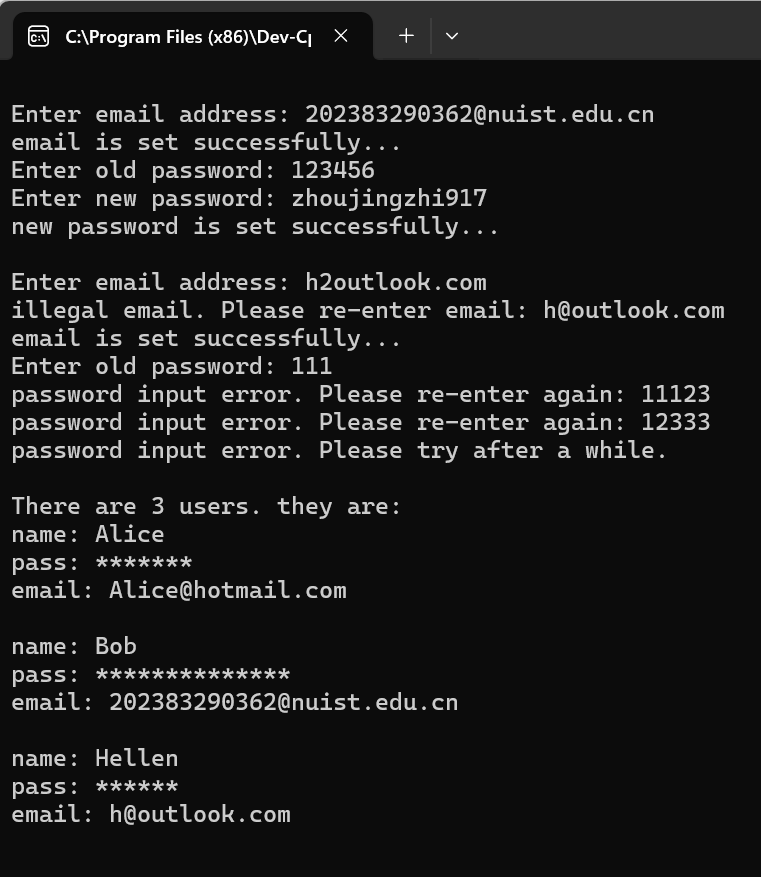
实验任务6:

1 #include"account.h" 2 #include<iostream> 3 4 using namespace std; 5 6 int main() 7 { 8 Date date(2008, 11, 1); 9 10 SavingsAccount accounts[] = 11 { 12 SavingsAccount(date, "03755217", 0.015), 13 SavingsAccount(date, "02342342", 0.015) 14 }; 15 const int n = sizeof(accounts) / sizeof(SavingsAccount); 16 17 accounts[0].deposit(Date(2008, 11, 5), 5000, "salary"); 18 accounts[1].deposit(Date(2008, 11, 25), 10000, "sell stock 0323"); 19 accounts[0].deposit(Date(2008, 12, 5), 5500, "salary"); 20 accounts[1].withdraw(Date(2008, 12, 20), 4000, "buy a laptop"); 21 22 cout << endl; 23 for (int i = 0; i < n; i++) 24 { 25 accounts[i].settle(Date(2009, 1, 1)); 26 accounts[i].show(); 27 cout << endl; 28 } 29 cout << "Total: " << SavingsAccount::getTotal() << endl; 30 return 0; 31 }

#include "account.h" #include<cmath> #include<iostream> using namespace std; double SavingsAccount::total = 0; SavingsAccount::SavingsAccount(const Date& date, const string& id, double rate) : id(id), balance(0), rate(rate), lastDate(date), accumulation(0) { date.show(); cout << "\t#" << id << " created" << endl; } void SavingsAccount::record(const Date& date, double amount, const string& desc) { accumulation = accumulate(date); lastDate = date; amount = floor(amount * 100 + 0.5) / 100; //保留小数点后两位 balance += amount; total += amount; date.show(); cout << "\t#" << id << "\t" << amount << "\t" << balance << "\t" << desc << endl; } void SavingsAccount::error(const string& msg)const { cout << "Error(#" << id << "):" << msg << endl; } void SavingsAccount::deposit(const Date& date, double amount, const string& desc) { record(date, amount, desc); } void SavingsAccount::withdraw(const Date& date, double amount, const string& desc) { if (amount > getBalance()) error("not enough money"); else record(date, -amount, desc); } void SavingsAccount::settle(const Date& date) { double interest = accumulate(date) * rate / date.distance(Date(date.getYear() - 1, 1, 1)); //计算年息 if (interest != 0) record(date, interest, "interest"); accumulation = 0; } void SavingsAccount::show() const { cout << id << "\tBalance:" << balance; }

1 #pragma once 2 #include"date.h" 3 #include<string> 4 5 class SavingsAccount 6 { 7 private: 8 std::string id; 9 double balance; 10 double rate; 11 Date lastDate; 12 double accumulation; 13 static double total; 14 void record(const Date& date, double amount, const std::string& desc); 15 16 void error(const std::string& msg)const; 17 18 double accumulate(const Date& date) const 19 { 20 return accumulation + balance * date.distance(lastDate); 21 22 } 23 public: 24 SavingsAccount(const Date& date, const std::string& id, double rate); 25 const std::string& getId() const { return id; } 26 double getBalance() const { return balance; } 27 28 double getRate() const { return rate; } 29 30 static double getTotal() { return total; } 31 32 void deposit(const Date& date, double amount, const std::string& desc); 33 34 void withdraw(const Date& date, double amount, const std::string& desc); 35 36 void settle(const Date& date); 37 38 void show() const; 39 };

1 #include"date.h" 2 #include<iostream> 3 #include<cstdlib> 4 5 using namespace std; 6 7 namespace 8 { 9 const int DAYS_BEFORE_MONTH[] = { 0,31,59,90,120,151,181,212,243,273,304,334,365 }; 10 } 11 Date::Date(int year, int month, int day) :year(year), month(month), day(day) 12 { 13 if (day <= 0 || day > getMaxDay()) 14 { 15 cout << "Invalid date: "; 16 show(); 17 cout << endl; 18 exit(1); 19 } 20 int years = year - 1; 21 totalDays = year * 365 + years / 4 - years / 100 + years / 400 + DAYS_BEFORE_MONTH[month - 1] + day; 22 if (isLeapYear() && month > 2) totalDays++; 23 } 24 int Date::getMaxDay()const 25 { 26 if (isLeapYear() && month == 2) 27 return 29; 28 else 29 return DAYS_BEFORE_MONTH[month] - DAYS_BEFORE_MONTH[month - 1]; 30 } 31 void Date::show() const 32 { 33 cout << getYear() << "-" << getMonth() << "-" << getDay(); 34 }

1 #pragma once 2 class Date 3 { 4 private: 5 int year; 6 int month; 7 int day; 8 int totalDays; 9 public: 10 Date(int year, int month, int day); 11 int getYear()const { return year; } 12 int getMonth() const { return month; } 13 int getDay()const { return day; } 14 int getMaxDay()const; 15 bool isLeapYear()const 16 { 17 return year % 4 == 0 && year % 100 != 0 || year % 400 == 0; 18 } 19 void show()const; 20 int distance(const Date& date)const 21 { 22 return totalDays - date.totalDays; 23 } 24 };
实验结果:
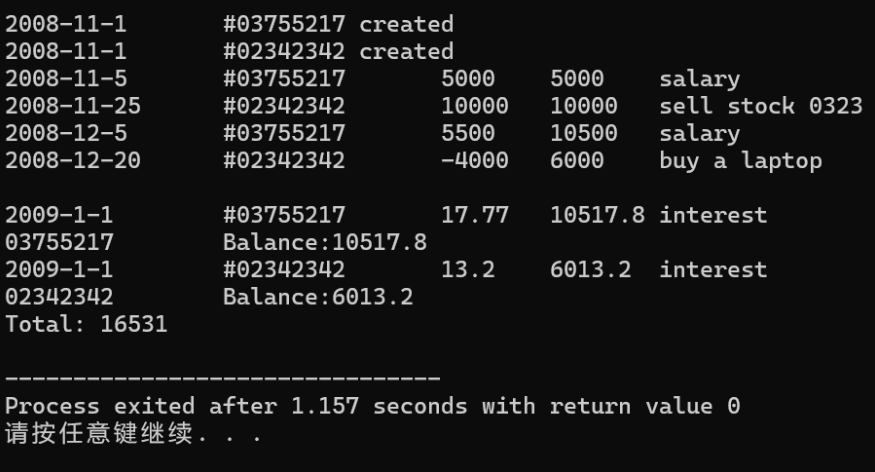
改进建议:
-
使用
this指针:在类的方法中,建议使用this指针来引用当前对象,以避免与参数或局部变量的名称混淆。 -
金钱处理类:在处理金钱相关的操作时,建议引入一个专门的金钱处理类,以避免由于浮点数精度问题导致的计算错误。
-
适当使用inline函数来提高程序运行效率
-
常量成员函数:对于不修改类成员变量的函数,建议将其声明为常量成员函数(使用
const)。例如,getBalance()和getId()等函数应标记为const,以明确其只读性质。



